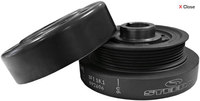Top 3 Tips for a More Powerful Engine

How do you get more power from your car's engine? When planning a build, there are three major areas to consider: adding oxygen, using that oxygen, and reducing parasitic losses.
Got Oxygen?
Your car's engine makes power by oxidizing hydrocarbons: the carbon and hydrogen in the fuel bond with oxygen, energy is released and the resulting explosion moves the piston. The primary purpose of most engine mods is to get more oxygen into the engine. From there, more fuel can be added to create more power.
A cam has lobes that push the valve open. Changing the shape of these lobes can make the valves open further and longer, giving more time for air to enter the combustion chamber and exhaust to leave the chamber. If the exhaust and intake valves are open at the same time, the exiting exhaust gases can pull in fresh fuel and air from the intake, AKA "scavenging."
A supercharger is a big belt driven pump that forces more air into the engine. Driving the supercharger requires power, but the power that can be extracted from the additional air more than makes up for it. A turbocharger is a supercharger that uses exhaust gases to drive its air pump, reducing power requirements but adding a delay as the turbine spools up to speed.
Nitrous injection adds oxygen directly by spraying nitrous oxide (NO2) into the intake. This is a simple system that provides extra power only when it's needed, but it's easy to forget that it still puts a lot of strain on the engine, requiring some of the same precautions used with a supercharged or turbocharged motor.
Does Everything Match?
Stock systems have some built-in performance potential, but as modifications get more extreme, every part from the air filter to the tailpipe needs to be taken into consideration.
Let's say you're looking to do some major top end work, adding a radical cam and heavily ported heads. Here's what you need to consider:
Stock Mustang V8 components old and new can handle a lot of power from the factory, but the bottom end may need to be beefed up to handle extreme builds. If the cams have too much lift, the pistons may need to be replaced with a set that have indentations to accommodate the valves.
The intake manifold, throttle body, air filter and associated hoses need to be big enough that they aren't a bottle neck when air is pulled into the engine. Likewise, the exhaust system needs to handle the extra gases being pumped out of the exhaust ports.
The fuel system needs to be re-tuned to deliver more fuel to match the increased airflow both to ensure the engine doesn't run lean and to get the most power from the new setup. If the fuel demands are too high, a bigger in-tank fuel pump or an external pump may need to be added to keep up. The ignition advance may also need to be changed to get the most out of the engine modifications.
Lastly, the ignition timing may need to be set later to work with increased combustion pressures caused by an increased compression ratio or added boost pressure. Simply put, more air and fuel means less space between molecules, and that means a faster burn.
How Much Power is Reaching the Tires?
Making more power is one thing, but parasitic losses should also be taken under consideration. Installing an underdrive pulley will reduce the speed at which the accessories are driven, conserving power. Removing the air conditioner and switching from power to manual steering means two fewer things your engine needs to power.
Ready to Start Making Power?
Whether you want to add some more oomph to your daily driver or you're building a race car, Anderson Ford Motorsport carries what you need. We've helped customers build the Mustangs of their dreams for decades, so we know what works on these cars.
Recent Posts
-
Bringing the Fox Body Mustang into the 21st Century with Holley Terminator X
Anderson Ford Motorsport has been in the Fox Mustang performance industry since 1989. One of the bi …22nd Oct 2021 -
Roush Supercharger install on a 2019 Ford Mustang
Check out this 2019 Ford Mustang before and after we installed a Roush Supercharger. …21st Feb 2020 -
All Blower Installations are not Equal.
Why Should You Choose a Company to Install Your Blower That Has a Dyno Facility In-House?Are all de …24th Jan 2020


